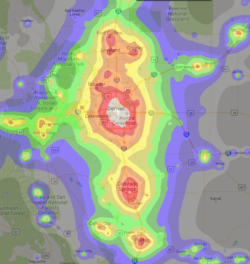“Star light, star bright,
First star I see tonight,
I wish I may, I wish I might,
Have this wish I wish tonight.”
Anonymous
Many a youngster (and maybe some “young at heart”) have stood waiting patiently for the last light of day to set, anticipating a glimpse of the first star. Today, due to the ever increasing population of major cities and their surrounding suburbs, we are now encountering what is known as “light pollution.” NASA has created a beautiful map illustrating the areas in the United States with the highest concentrations of night time illumination. It resembles a star map in reverse. This is why peering toward the horizon and above is becoming increasingly difficult to locate any stars at all. History records the efforts of many marvelous star gazers, when city light was less abundant.
According to Poor Richard’s Almanac, the first recorded sightings of a supernova in the constellation Cassiopeia occurred in 1572. This peek into space was achieved without any tools other than the naked eye. It wasn’t until 1608 when the refracting telescope made it possible to bring the night sky closer to view. We can thank the early effort of Galileo, Lippershey and Kepler to make this possible. There are many modern and affordable astronomy tools available to aid our naked eye. A few clicks away are some excellent star locator Apps, electronic telescopes will do the locating for you, and good old-fashioned paper star maps, but you will still need a dark night sky.
The best viewing for meteor showers, locating constellations, galaxies, and planets will always be in a dark, night sky. In the Denver metro area these sightings are faint. Below is a “Light Map” or “Where Can I Find The Darkest Sky For Viewing The Night Sky?”
DarkSky Finder Map
Best Viewing is shown in Grey Shaded Areas ~ 3 hours away
Second Best Viewing shown in Purple Shaded Areas ~ 2 hours away
Third Best Viewing shown in Green Shaded Areas ~ 1-½ hours away
Notable Night Sightings in November:
🌗The Moon is now in its Last Quarter or waning phase.
🌗The constellation Cassiopeia is the brightest in November. It is located opposite the Big
Dipper and resembles a large, open “W” shape.
🌗The Leonid Meteor Shower Is expected to peak on November 17th and 18th, producing
about 15 meteors per hour. Visibility should be good because it coincides with the New
Moon (a.k.a. The Dark Moon)
🌗The constellation Orion is visible in the fall-winter sky
🌗The large spiral galaxy – Andromeda (M31) can be seen with the naked eye (positioned
below Cassiopeia)

